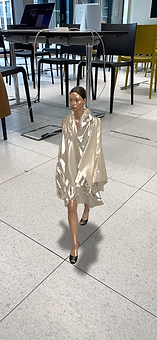The Wool Story

Design To Augment Instead of Neglect
The Team:
Coco Huberts
Youwen Zhang
Jinyu Zhou
Haili Wu
The Project Intro:
In this project, I worked with three other professionals with different backgrounds and skill sets, exploring the new possibility of human-object interaction by creating a ‘Digital Surface’ for a physical garment provided by our clients.
Design Process

Discover
Although we have a tight schedule, we still decided to take a critical approach to the concept of digital surface and digital fashion, which potentially helped us produce a meaningful outcome.
During the research, I realised while we often talk about designers in terms of brand, we give very little thought to the individuals, craftsmanship, and stories behind a garment. Within an era in which digital fashion and automated generating forms become more common, I believe the value of a garment lies in the stories that created it. Therefore, instead of reproducing physical clothes in the digital world or helping people in the physical world to wear fictional garments, I believe the digital world should enhance the physical world. The idea got approval from the team and laid a solid foundation for our concept development and presentation. To make the concept more ‘compact’ through our project journey, one of the group members help us to frame it into a catchphrase: “Argument instead of neglect”.

ideas Bloom
Following our project manifesto, we brainstormed together to generate as many ideas as possible because we believe we should push our creativity and storytelling skill to explore possibilities within our brief. However, we are also aware that the team has a limited skill set and time for execution. Therefore, I also spent some time alongside our idea generation process to go through online tutorials and evaluate execution possibilities for our ideas. This process helps balance the creative concept and a convincing prototype, which I think changed me to think and work as a designer, go beyond just thinking big, and build based on what I had. In the concept we choose to push forward, we plan to create a user experience triggered by the physical garments and unpack its story, allowing the audience to understand the designer’s thoughts in an immersive environment. The concept potentially changes the retail experience and how people understand fashion.




Process of making
Although I evaluated the execution possibility previously, the team still faced unexpected problems. Firstly, we realised the original 3D model we received from the client is not fully matching the physical garment, which means the AR would not recognise the garments in the physical world. Secondly, Clo 3D, where the digital garment was based, has issues with the planned software workflow. Thirdly, we also realised the scenario we are picturing in our concept could not run smoothly on the current hardware due to the number of polygons we are working with. Fourthly, unity, the essential software to build the AR scenario, did not support vertex animation. To go through the challenges within the limited deadline, the team separates tasks into each member. Some people focus on making asserts for the scenario, some plan to make the concept with AfterEffect as an alternative approach to show our idea, and I continue to seek for solution to make our concept works in AR. Good cooperation and alternative method allow us to face the challenges directly with less risk, and I still think this is an excellent approach for short timeframe projects.



Deliver & Reflection
The outcome is a functioning prototype with critical thinking, which received much positive feedback and discussion. I am proud of the development because my team can achieve this within two weeks. As a simple reflection and summary of this project, I think the biggest takeaway is not about technical skillset or knowledge of digital fashion, although they are also significant. My biggest takeaway is about working as a designer, which needs to be brave and intelligent in front of the problem and never stop learning new skills. I think the group balanced a creative approach and technical output; our creative approach allows us to know more about the technical aspect. Technical knowledge makes the idea more complete, forming a positive loop. However, suppose we can do the project one more time. In that case, I think I can also think more about the visual representation of our idea and how we can produce a more compelling outcome that unpacks the designer’s work more immersively.
